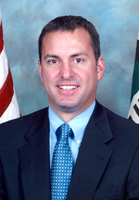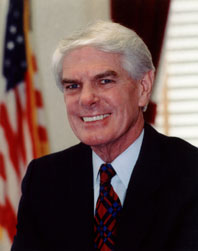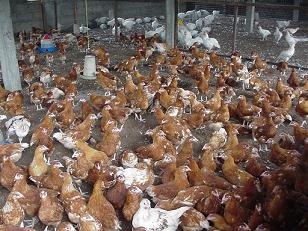Some people really know how to spoil a good time.  I was at one of San Bernardino County Supervisor Paul Biane’s signature first-class fundraisers November 2nd in Rancho Cucamonga, sipping Biane Brothers wine and anticipating later hearing Paul’s announcement for re-election next June. Read about it here. Then the keynote speaker, Hugh Hewitt, took a detour from his characteristically rousing speech and spent a full five minutes describing to the hushed audience a potential bird flu pandemic that could kill millions of people. He discussed the possibility that the new avian influenza "H5N1" strain in Southeast Asia could become communicable among humans in the future, and noted that in Asia people in their prime who’ve contracted the virus from bird sources are dying at a 50-percent rate. By contrast, most influenza bugs are generally only life threatening to the very young and elderly, as well as those with compromised immune systems. Hewitt’s point was that federal, state and local governments need to be ready for a pandemic that worst-case scenarios say could kill 150 million people worldwide if the virus mutates and spreads from Asia. Read some of Hewitt’s related thoughts on his blog here.
I was at one of San Bernardino County Supervisor Paul Biane’s signature first-class fundraisers November 2nd in Rancho Cucamonga, sipping Biane Brothers wine and anticipating later hearing Paul’s announcement for re-election next June. Read about it here. Then the keynote speaker, Hugh Hewitt, took a detour from his characteristically rousing speech and spent a full five minutes describing to the hushed audience a potential bird flu pandemic that could kill millions of people. He discussed the possibility that the new avian influenza "H5N1" strain in Southeast Asia could become communicable among humans in the future, and noted that in Asia people in their prime who’ve contracted the virus from bird sources are dying at a 50-percent rate. By contrast, most influenza bugs are generally only life threatening to the very young and elderly, as well as those with compromised immune systems. Hewitt’s point was that federal, state and local governments need to be ready for a pandemic that worst-case scenarios say could kill 150 million people worldwide if the virus mutates and spreads from Asia. Read some of Hewitt’s related thoughts on his blog here.
 Biane, at the Board of Supervisors meeting following Hewitt’s remarks, requested that the San Bernardino County Department of Public Health return to the Board on November 22nd to outline the County Plan for dealing with the Avian Flu threat. The day before that, Congressman Jerry Lewis (R-Redlands) introduced the "Influenza Preparedness and Prevention Act", which is intended to support, complement and fast-track the President’s $7.1 billion National Strategy for Pandemic Influenza.
Biane, at the Board of Supervisors meeting following Hewitt’s remarks, requested that the San Bernardino County Department of Public Health return to the Board on November 22nd to outline the County Plan for dealing with the Avian Flu threat. The day before that, Congressman Jerry Lewis (R-Redlands) introduced the "Influenza Preparedness and Prevention Act", which is intended to support, complement and fast-track the President’s $7.1 billion National Strategy for Pandemic Influenza.  Key components of the strategy include international surveillance, domestic surveillance, vaccine development, stockpiling of anti-virals, communication and state and local preparedness. The bill would also direct the Department of Agriculture and U.S. Fish and Wildlife Service to intensify efforts to detect and control influenza outbreaks in animals and birds, and would set criteria for states’ preparedness plans. Read more here.
Key components of the strategy include international surveillance, domestic surveillance, vaccine development, stockpiling of anti-virals, communication and state and local preparedness. The bill would also direct the Department of Agriculture and U.S. Fish and Wildlife Service to intensify efforts to detect and control influenza outbreaks in animals and birds, and would set criteria for states’ preparedness plans. Read more here.
During the 20th Century, the emergence of several new influenza A Virus subtypes caused three pandemics, all of which spread around the world within a year of being detected. In 1918-19, "Spanish Flu" caused the highest number of known influenza deaths: more than 500,000 in the U.S. and 50 million worldwide. In 1957-58, "Asian Flu" caused about 70,000 deaths in the U.S. The most recent pandemic was in 1968-69, when "Hong Kong Flu" caused about 34,000 deaths in the U.S. Because of the potential magnitude of a pandemic (including impacts on the economy, travel and goods movement), federal, state and local governments are planning in terms of disaster preparedness as well as disease prevention and treatment. The State Department of Food and Agriculture is testing chickens at feed stores and commercial poultry operations. 
So while Hewitt’s bird flu remarks were somewhat of a buzz-kill, he was doing what Hewitt does very well — talking about important things that more political people need to be thinking about, talking about, planning for and responding to. Hewitt is of the opinion that local governments need to be doing more to respond to this threat. I would encourage all of you to read up on your local area’s efforts. And be aware that as public awareness and fear of Avian Flu begins to reach critical mass, the media and public are starting to look for answers as to what’s being done to protect our population. In his article entitled The Flu Pandemic Preparedness Snowball, well-regarded risk communication expert Peter Sandman delivers the following advice to opinion leaders: "A severe H5N1 influenza pandemic might — or might not — happen. We hope it won’t. We need to get better prepared, now, in case it does. That’s not a mixed message. It’s the right message." Read more here.

